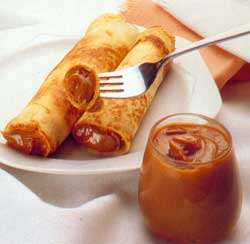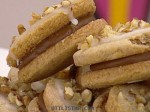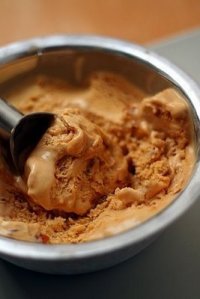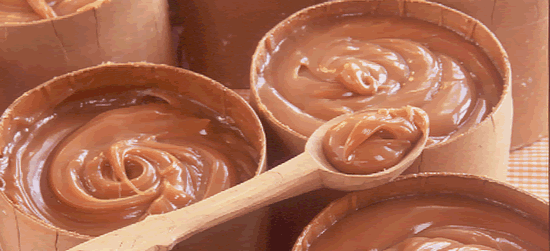Dulce de leche is the cure-all medication for all times of the day for all you study abroad students and travelers in Buenos Aires, and simply cannot be missed! It is hidden in your morning facturas (pastries), found in the kioscos in the middle of your alfajores, even added to your ice creams, coffees, and to be eaten by the spoonful. Those taking Mente Argentina Cooking Courses in Buenos Aires have experienced the secret to making that delicious dulce! If your friends or family want a gift from your study abroad experience in Buenos Aires, DDL (dulce de leche) is the ultimate gift to bring on home, an authentic Argentine treat! Here is the 411 on dulce de leche, what it is, where to find it, and how it’s made:
What: Dulce de Leche is a type of caramel, a sticky and sweet Argentine specialty that seems to go in and on just about every breakfast, snack and dessert. Pastries of all shapes and sizes, especially croissants, known as medialunas, are filled with dulce de leche. Every grocery store has at least half an aisle devoted solely to dulce de leche. Right up there with cafe and carne, dulce de leche is an Argentine essential. Spread it on bread, fruit, crepes and just about anything else you can think of!
There are different accounts of how dulce de leche was first made, but the most popular myth (according to Argentineans) seems to be that dulce de leche originated in Argentina in 1829 in Cañuelas, a city in the province of Buenos Aires. The full story can be found here, but our cliffsnotes goes as such: Nearing the end of a war, General Lavalle cane exhausted the General Manuel de Rosas campsite, and finding that Rosas was not there, he took a nap in his tent. Meanwhile, a serving woman was preparing la lechada by heating milk and sugar for the camp, and finding the enemy in the tent, ran off to tell soldiers, forgetting about la lechada cooking on the stovetop. The overcooked lechada had truned brown and jelly-like. The say a brave yet very hungry soldier tried the “ruined” batch of lechada, and as we all know, it must have been a big hit!
Where: DDL in both cookies and cream
Alfajores: Alfajores are a particular kind of argentine cookie, another quintessential Argentine treat, as evidenced by endless array of varieties and impassioned discussions about them.  Find them in a kiosco or learn how to make them in your Argentine cooking course in Buenos Aires
Find them in a kiosco or learn how to make them in your Argentine cooking course in Buenos Aires
The alfajor (pronounced: alfa-hor) is actually a traditional Arabic confection, still called by its original name alajú in some regions of Spain. The sweet originated in the Middle East and made its way to Spain and was finally brought to South America by Spanish colonists. The basic components of a Middle Eastern alfajor are flour, honey, almonds, sugar and spices like cinnamon and cloves.
 Alfajores can be found all over the world in Spain, Argentina, Ecuador, Peru, Chile, Uruguay, Mexico and southern Brazil, but recipes and styles vary widely according to country, and region. Thus, even though the Argentine alfajor originated from the Middle Eastern alfajor, the availability of ingredients and differences in traditions and flavor preferences have resulted in a very different confection.
Alfajores can be found all over the world in Spain, Argentina, Ecuador, Peru, Chile, Uruguay, Mexico and southern Brazil, but recipes and styles vary widely according to country, and region. Thus, even though the Argentine alfajor originated from the Middle Eastern alfajor, the availability of ingredients and differences in traditions and flavor preferences have resulted in a very different confection.
Alfajores in Argentina begin with soft cookies of a cake-like consistency. The most simple and traditional alfajor is composed of two cookies with dulce de leche in the middle, finished off by rolling the edges in finely shredded coconut. From there the seemingly endless variations begin.
 Some alfajores are composed of 3 or 4 cookies to create a layering effect and a thicker, taller alfajor. Some are filled not only with dulce de leche, but also chocolate. Some are sprinkled with powdered sugar or dipped, bañado, in chocolate- white, milk or dark. Some alfajores are drizzled with icing, some are rolled in nuts like chopped walnuts or almonds, and some are topped or filled with a sweetened peanut butter paste called mantecol. Some have a little bit of raspberry jam inside of the top cookie, called alfajores ojitos. Some are made with chocolate cookies instead of the more traditional plain cookies which are like sugar/shortbread cookies. The astounding variety makes buying an alfajor a tough decision even at kioskos, small convenience shops where they are short on space, but never on the variety of different brands and variations of alfajores.
Some alfajores are composed of 3 or 4 cookies to create a layering effect and a thicker, taller alfajor. Some are filled not only with dulce de leche, but also chocolate. Some are sprinkled with powdered sugar or dipped, bañado, in chocolate- white, milk or dark. Some alfajores are drizzled with icing, some are rolled in nuts like chopped walnuts or almonds, and some are topped or filled with a sweetened peanut butter paste called mantecol. Some have a little bit of raspberry jam inside of the top cookie, called alfajores ojitos. Some are made with chocolate cookies instead of the more traditional plain cookies which are like sugar/shortbread cookies. The astounding variety makes buying an alfajor a tough decision even at kioskos, small convenience shops where they are short on space, but never on the variety of different brands and variations of alfajores.
 There is always great debate about which brand of alfajores is the best, it is often narrowed it down between Havanna and El Cachafaz where there seems to be a current gridlock. Regardless, there is a seemingly infinite number of different brands and varieties of alfajores that each brand produces so it is impossible to say which is best. But I can say with certainty that the best way to form an opinion is to start sampling!
There is always great debate about which brand of alfajores is the best, it is often narrowed it down between Havanna and El Cachafaz where there seems to be a current gridlock. Regardless, there is a seemingly infinite number of different brands and varieties of alfajores that each brand produces so it is impossible to say which is best. But I can say with certainty that the best way to form an opinion is to start sampling!
Helado: The dulce de leche ice cream is always a favorite. For those of you looking to kick back after your internship in Buenos Aires, the heladerías (ice cream shops) in the city such as Freddo and Volta are known to be among the best. To help you navegate the different varieties of dulce de leche helado, let Mente Argentina give you a quick break down:
- DDL con almendras: dulce de leche ice cream with crushed almonds
- DDL granizado: dulce de leche ice cream with chocolate bits
- DDL con frutas secas y nueces: dulce de leche ice cream with nuts and dried fruit, my personal favorite!
- Banana Split: Banna ice cream (made with real banana!) with Dulce de leche and chocolate bits
- Tramontana: dulce de leche ice cream and chocolate cookie
For a full evaluation on the best place to find some icecream, check out this article from the LA Times travel section!
Dulce de Leche Professionals: When in a city where Dulce de Leche is found around every corner, it’s hard to narrow down who is truely the best, but our suggestions are La Salamandra, a dulce de leche and mozzarela cafe (delcious both seperate and together, try their mozzarella and dulce de leche desert!), and Havanna, known to have some of the best and most popular alfajores, and
How: Lastly, and maybe most importantly, if you want to make your own dulce de leche, it is simple enough if you have the time and energy! Lost of our Mente study abroad students go through the common dulce-withdrawl process, since nothing can quite replace this agentine specialty! Many people say its like making caramel, which is only partially true. Dulce de leche is made by heating sweetened milk over a stove top, and can be flavored with vanilla, cinamon (canela in spanish), chocolate, or kept as is for the original flavor.
These reciepes you can learn during your argentine culinary courses in buenos aires, while you’re here, and each cocinero has their own secret. But if you’d like to give it a try before coming to argentina, here are two different recipes, one using whole milk and one through the combination of condensed and evaporated milk, which should save you some time!
So you study abroad students, invite over your friends for a dinner party and showcase your cooking skills, pop by your local kiosco and grab some delicious snack filled with the typical dulce dessert, or hit up some local dulce de leche cafes that specialize in the dulce, because it’s not the be missed!
Caitlin McCoy
Edited: Rachel Sherman

